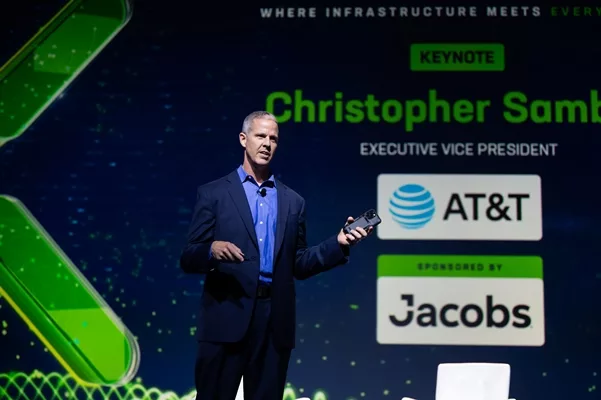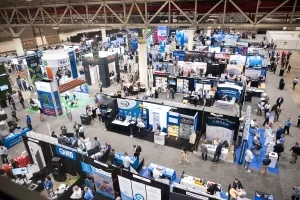In the latest edition of PR Vibes by Calysto, Laura Borgstede, the public relations company’s CEO reported on the Connect (X) 2023 event held at Morial Convention Centre, in New Orleans, USA from May 8-10, 2023. Here’s her report.
As the name implies, the increasingly popular Connect (X) North American business technology event is all about connectivity. The show is a good reminder of the importance of the underlying telecom infrastructure and networks. Without it, all the latest and greatest software and cloud solutions could not communicate.
Connect (X), a relatively young, mid-sized event with a theme this year of “Connectivity Everywhere,” was launched in 2018 by The Wireless Infrastructure Association or WIA. The show is gaining traction. WIA reported 3,500 attendees this May in New Orleans, up from 3,000 in the spring of 2022 (Denver) and 2,200 in the fall of 2021 (Orlando).
Per WIA, the large majority of Connect (X) attendees (85%) were purchasing influencers or decision-makers within the wireless networking, services and supplier ecosystem, so it’s an excellent face-to-face opportunity for establishing relationships and crafting business deals. Wireless operators, cell tower owners, network equipment vendors and enterprise leaders alike could not miss with more than 50 sessions within seven main tracks that focused on various facets of the connectivity sector:
- Infrastructure and networks
- Capital and finance
- Technology evolution
- Workforce and supply chain
- In-building connectivity
- Community connectivity
- Policy and regulation

The show kicked off with a “Supply Chain Matchmaking” meet and greet session for procurement teams and suppliers. To streamline the process and save time, buyers identified their needs prior to the conference and accepted or rejected meeting requests in advance from suppliers. The afternoon also included a Supplier Diversity Summit for those seeking suppliers from minority-owned businesses. Attendees carved out time for some New Orleans style fun at the annual Golf and Crawfish & Cornhole tournaments.
Of high interest was Day One’s CellSat Forum that addressed the emerging “space race” the role of satellites in 5G, so-called “cell towers in the sky.” There is a growing market for space-based mobile broadband in underserved areas and for temporary coverage when natural disasters occur. CellSat workshops and sessions honed in on the basics: understanding acronyms and the latest “tech-speak,” current and evolving satellite services and markets, the role of satellites in the larger telecoms industry, as well as financial, technological and policy matters relevant to satellite operators. AT&T’s networking chief, Chris Sambar continued the satellite conversation in his keynote, highlighting recent testing of direct-to-device (D2D) satellite connectivity via its partnership with AST SpaceMobile.
Key show topics included mobile towers, private networks, fixed wireless, small cells, spectrum, WiFi, decentralised wireless (DeWi), neutral hosts, shared infrastructure, and of course 5G and 6G technologies.
The Buzz

5G adoption is progressing but has not fully taken off as yet. And, while the game is on, this technology is still seeking a lucrative, mass-market use case. It will inevitably come, but for now, making money from 5G was the main question on minds at the show. Fixed wireless access (FWA) is looking like the first revenue-generating innovation based on 5G, according to Crown Castle’s CEO, Jay Brown. UScellular’s EVP and CTO Mike Irizarry echoed this, calling out his company’s success with FWA, which he says now has 100,000 subscribers.
Speakers and presenters at the conference naturally touted plans, progress and successes around their companies’ products and services.
Yet, there remains a looming challenge that entered all discussions: the North American economy is slowing amid rising inflation, higher interest rates and fears of recession. Major and minor players in the wireless industry are all trying to navigate this downturn and stay afloat. Dish, for one, is slowing down its 5G network spend this year. UScellular is one of many announcing lay-offs amid customer losses.
A number of the breakout sessions delved into the specifics about how higher capital costs are impacting 5G builds. Which segments of the wireless industry are most likely to weather this economy and survive long-term? Should a company diversify its portfolio? What can infrastructure companies do to mitigate ongoing supply chain issues and prevent construction delays? Why have operators failed to fully monetise 5G as yet?

Economics is also driving the trend toward infrastructure sharing to cut costs. Unheard of before, this arrangement among competitors is now possible thanks to Open RAN and virtualisation technology.
Along these lines, a new flavour of neutral host networks is emerging, enabling the sharing of network components like cell towers, access networks and spectrum from different operators. Neutral host services avoid vendor lock-in and make it easier for customers to get carrier-grade private wireless and public cellular network capabilities in one interoperable network. For example, the neutral host model enables public operators to connect indoor and outdoor areas that are difficult to reach with only their public networks. A well-attended Connect (X) panel discussed compelling neutral host use cases that span vertical sectors like campuses, hospitals, retail spaces, schools and rural areas that need better coverage but also want privacy and security for their users.
“Bridging the digital divide” continues to be an important conversation. Experts at the show discussed how state and local government bureaucracy stands in the way of allocating federal funds equitably and effectively. Centralising broadband funding allocation would be difficult, but if achievable, would lessen delays in planning and deploying broadband connectivity projects.
To this end, National Telecommunications & Information Administration (NTIA) is offering US$42.5 billion (€42.5 billion) in Broadband Equity, Access and Deployment (BEAD) program funding for wireless operators to help close this divide by serving rural areas with FWA or other wireless technologies.
The author is Laura Borgstede, CEO of Calysto Communications.
Comment on this article below or via Twitter: @VanillaPlus OR @jcvplus






